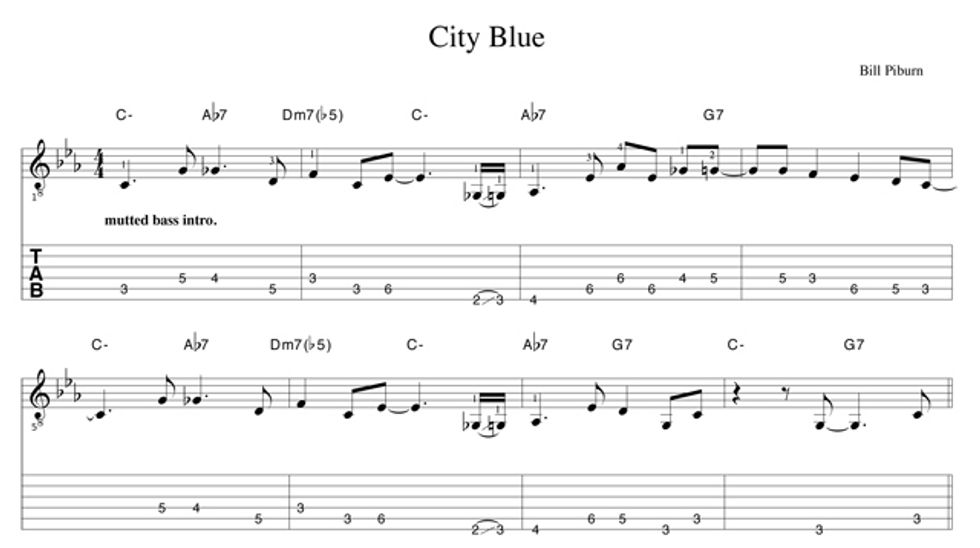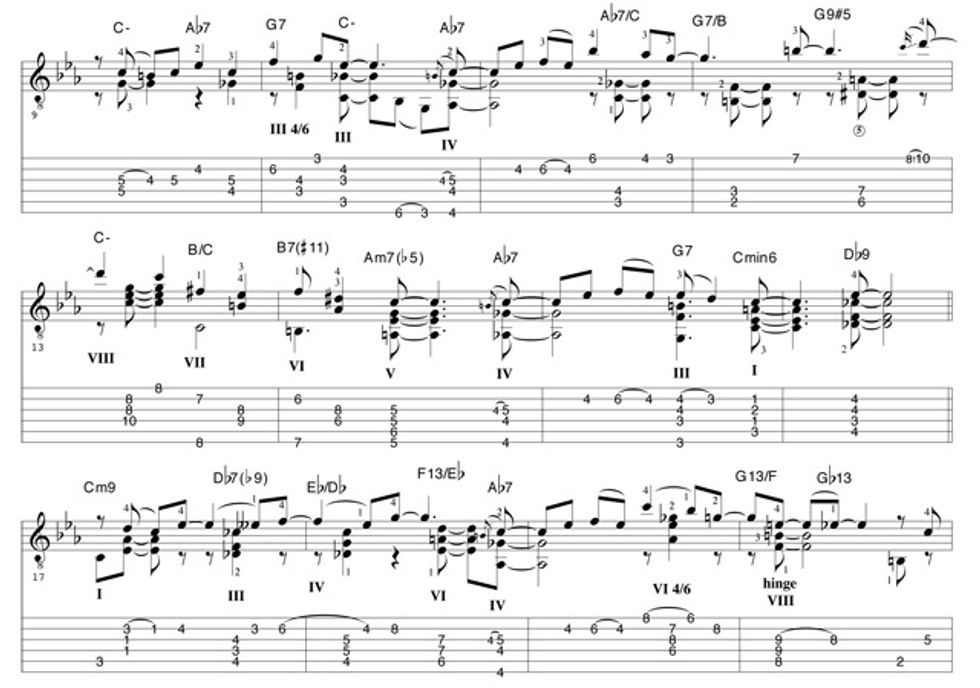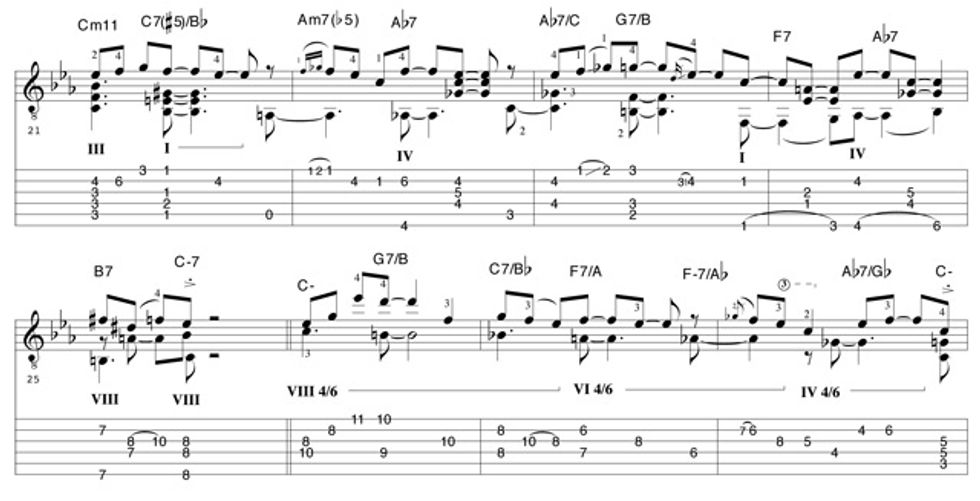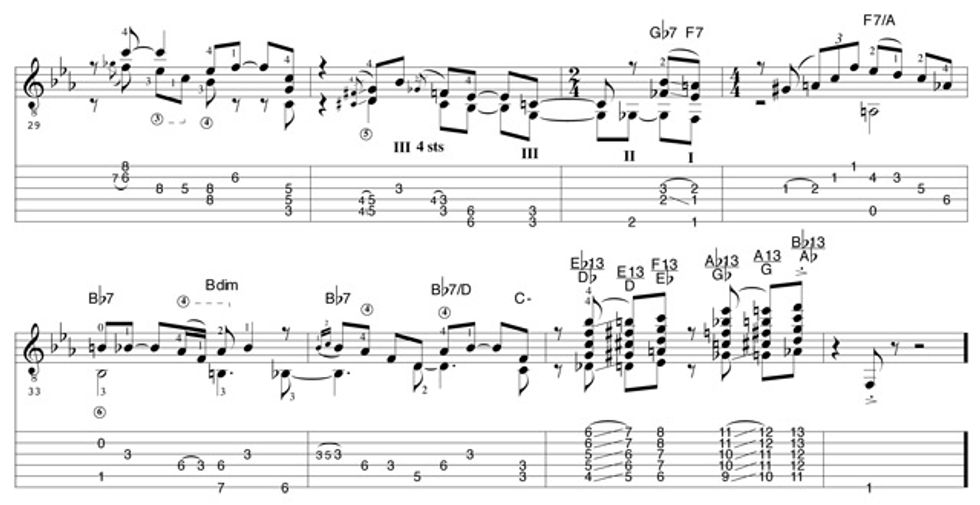Welcome back to another installment of "That Can Be Arranged." We are going to take a look at “City Blue,” an original written for this column. We are going to look at chord voicings, chord alterations, chord texture, ornaments, syncopation, tritone 7th and tritones used as altered dominate sounds. We will also discuss implied harmony. At times these points of topic may overlap, because multiple things can happen at once.
Implied Harmony
When dealing with harmony, one could say that a chord has to have the major or minor third to define the quality of the chord, and that is true in a textbook definition. In the real world of hearing music, whether or not a chord is major, minor, diminished, altered, etc. is often determined by the context; what follows or precedes is just as important, if not more important. Perception becomes reality because our ear perceives the sound. This perception is not only based on what precedes and follows a sound but is also affected by the expected harmony of the key center we are in at the moment.
A few examples of implied harmony are as follows:
Measures 1 through 8 imply a harmony, even though it’s just a bass line with no chord or full chord structures. This is a perfect example of implied sound. It’s about where the line leads and what precedes it.
Notice the chord symbols in these measures and see if you agree.
In measure 9 the chord symbol indicates C minor; however, there is no minor third in the chord. Why does it sound minor? The answer is in the preceding bass line and with what follows. The second chord in measure 9 is indicated as an Ab7. Why does this imply the sound of Ab when there is no Ab note in the chord? The answer is in the key center which contains Ab. The flat 7th and third that follow also affect the perception. It’s about context and perception. You’ll see the very same thing happen on the G7 in measure 10.
The last implied sound I will point out is an altered sound that happens in measure 12. On beat three, you’ll see the chord symbol G9#5. The altered sound happens on the upbeat. This sound is perceived as an altered G only because of the reference of G that happens in the first beat of the measure. You see, we retain that musical reference. If I had played the same notes alone you might hear it as a B7th chord – why? They contain the same notes. The answer is reference; in other words, implied harmony. As you play other arrangements and arrange for yourself, keep it in mind to look for these implied sounds and use them to your advantage.
Syncopations
Syncopations are nothing more than playing the note or chord on the upbeat, a.k.a. the weak beat. They can be cut short or tied over into the following downbeat. Musicians refer to this as a ‘push.’ You can make the personal choice as to pushing the top of the chord, bass only or whole chord. For single note references take a look at the intro. Chord syncopations happen in several places within “City Blue.” First, take a look at the Ab7 in measure 10 going into measure 11 and then, take a moment to spot other syncopations. I encourage you to start using syncopations in your arranging and playing. It’s really a feel thing. Don’t overthink it, feel it.
Chord Voicings
Chords can and should vary in texture, meaning density or number of notes played. At times I choose to play full chords and other times just two or three notes. I like to vary the texture. This is always a choice done by ear. Use your ear but be aware of the choices you have.
Chord Texture
I only used a couple notes to outline the chord sounds in measure 9. As it moves into measure 10 ,you’ll see three note chords. In measure 14, you’ll see a four note chord on the Amin7 b5 and at the end of the piece in measure 35. I used several five note chords for a bigger and more dramatic ending.
Tritones
A tritone is an interval a raised 4th. This interval distance is created and found in all dominate 7th chords. The interval of a tritone happens between the third and the flat 7th of the chord. It’s a great tool to use and understand that we can outline the sound of a 7th chord by only using those two notes. The root of the chord can be left out. Take a look at the Ab7 in measure 9 and the G7th in measure 10. Look for the tritone shapes on the fingerboard. They are very useful; built off of the 6th, 5th, and 4th strings.
Tritone Used as Alterations
I’ve found that the tritone shapes can be moved around the guitar to imply altered sounds. The key is to first establish the the chord sound, as I did in measure 12. Beat one outlines the G7th while a tritone shape moved up to D# and A outlines the sound of G9 (#5). This is a powerful tool! If you incorporate it into your arranging and writing you’ll be amazed at the sounds you’ll find.
Ornaments
Ornaments are slides, slurs, hammer-ons and pull-offs that can really help the phrasing and feel off the music. Especially when it comes to the blues sound. Where would Ray Charles have been without slurring into the notes, both in his voice and piano? Where would B.B. King be without the bent slurs? In “City Blue” I do not use bent notes, but I do use many other ornaments.
I’ve discussed several topics in this article that I believe will make you a better player and arranger/composer. I personally use this every time I pick up a guitar. Give it consideration and, if you apply it, you’ll open new and exciting possibilities for your music.
Download PDF of notation - Download MP3 of "City Blue"
Search
Latest Stories
Start your day right!
Get latest updates and insights delivered to your inbox.
Premier Guitar features affiliate links to help support our content. We may earn a commission on any affiliated purchases.
The Latest
More for you
Most Popular
Don’t Miss Out
Get the latest updates and insights delivered to your inbox.














![Rig Rundown: Russian Circles’ Mike Sullivan [2025]](https://www.premierguitar.com/media-library/youtube.jpg?id=62303631&width=1245&height=700&quality=70&coordinates=0%2C0%2C0%2C0)






